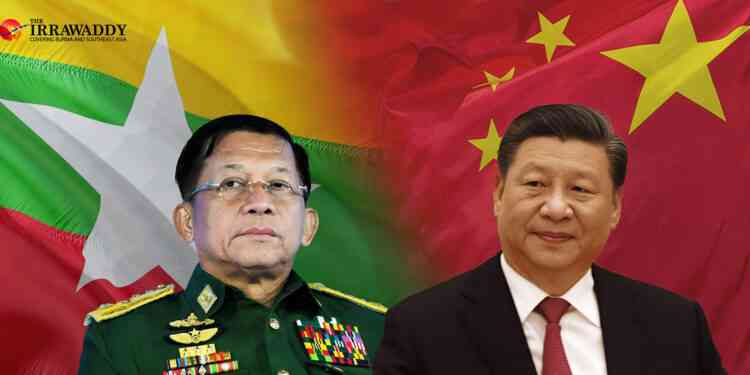
The Chinese Communist Party’s (CCP) deepening involvement in Myanmar’s political and conflict landscape has raised serious questions about Beijing’s intentions in and around the region. Its simultaneous engagements with the military junta and ethnic rebel groups reveal a dual-track strategy aimed at maintaining influence irrespective of who emerges as the dominant power within Myanmar. Whilst these overtures are frequently couched in terms of promoting regional stability, the wider implications suggest China’s ambitions to wield hegemonic influence.
China’s support for the Myanmar junta since the 2021 coup has been both material and diplomatic. Arms supplies, economic investment and political backing have helped the military regime maintain its hold on power amidst international isolation. Beijing’s strategic infrastructure projects under the Belt and Road Initiative (BRI), including the China-Myanmar Economic Corridor and the dual oil and gas pipelines connecting the Indian Ocean to China’s Yunnan Province, would not be possible without Myanmar. The junta’s control over these resources and trade routes has ensured China’s access to the region, bypassing the vulnerable Malacca Strait.
Even though China’s relationship with Myanmar is often framed through the lens of historical camaraderie, dubbed the “pauk-phaw” or fraternal bond, this rhetoric belies a calculated approach of embedding Beijing into Myanmar’s political and economic fabric. This has been enabled by the CCP’s engagements with the junta while granting developmental projects that aim to strengthen the military leadership’s authority domestically.
Hedging Its BetsHowever, the CCP’s alignment with the junta goes beyond economic pragmatism. By supporting the regime, China reinforces its image as a reliable partner to authoritarian governments, signaling to other regimes in its sphere of influence that Beijing prioritizes sovereignty and noninterference; principles that conveniently mask its own strategic motives.
Though China supports the junta, it has also maintained ties with Myanmar’s ethnic rebel groups, many of which control territories along the China-Myanmar border. The United Wa State Army (UWSA), for instance, receives weapons and tacit support from Beijing, ensuring that China remains a critical player in the event of a power shift in Myanmar. This dual engagement allows Beijing to hedge its bets and maintain leverage over both state and non-state actors, ensuring its interests are protected regardless of political outcomes.
Moreover, by supporting these factions, China secures the borderlands that are vital to its security and trade routes. These areas are critical not just for economic activity but also as buffer zones that shield China’s Yunnan Province from instability. Simultaneously, China’s engagement with rebel groups ensures it can act as a mediator in conflicts, promoting its regional image as an indispensable power broker.
Regional consequencesChina’s dual-track strategy in Myanmar also exemplifies its broader ambition to assert hegemony in Southeast Asia by leveraging control over strategic geography and sidelining multilateral frameworks like the Association of Southeast Asian Nations (ASEAN). This geographical dominance not only strengthens China’s economic foothold but also facilitates power projection far beyond its immediate borders and much deeper into its extended neighborhood.
By undermining ASEAN’s role in mediating Myanmar’s crisis, China has positioned itself as the central authority in resolving conflicts, thereby reorienting the regional order to its advantage. This deliberate bypassing of regional mechanisms has invariably weakened collective decision-making in Southeast Asia, enabling Beijing to dictate terms unilaterally. China has also effectively exploited ASEAN’s consensus-based decision-making process by using a ‘divide and rule strategy’. By influencing or pressuring certain member states including Myanmar, China has often prevented ASEAN from reaching a unified stance on contentious issues, such as the South China Sea disputes. This was notably evident during the 2012 ASEAN Foreign Ministers’ Meeting when host Cambodia, under Chinese influence, blocked a joint statement addressing South China Sea tensions, resulting in ASEAN’s first failure to issue a joint communique in its history. This strategy however, is not limited to Myanmar; but rather is part of a broader tactic deployed by Beijing to undermine established regional norms and agreements in the Southeast Asian region. For instance, despite commitments made under the 2002 Declaration on the Conduct of Parties in the South China Sea, China has continued its militarization of disputed islands without facing significant pushback from ASEAN due to internal divisions exacerbated by Chinese diplomacy. Similarly, China has initiated alternative regional frameworks that exclude and aim to diminish ASEAN’s role. For example, the Lancang-Mekong Cooperation mechanism involves countries along the Mekong River but operates outside of ASEAN’s purview, allowing China to influence ties with these nations while bypassing collective ASEAN mechanisms.
- Beijing seeks ASEAN support for dominance in South China Sea
- Renewed dynamism of Chinese economy a pivotal driving force for Asian recovery, integration
- China’s Myanmar playbook and its far-reaching regional implications
Keep Reading
Furthermore, China’s approach in Myanmar is also a promotion of authoritarian governance as a preferred model for stability and progress. By supporting both the military junta and ethnic rebel groups, Beijing has predominantly normalized the narrative that development can occur without democratic governance, directly challenging Western liberal democratic ideals. This strategy has also entrenched Myanmar’s dependency on China, as the junta relies on Beijing for financial aid, arms, and political backing. Such dependency reduces Myanmar’s sovereignty, making it increasingly susceptible to becoming a satellite state in China’s sphere of influence.
By enabling this economic and political reliance, Beijing has secured long-term leverage over Myanmar, ensuring its dominance in the region while further eroding local autonomy and regional stability.
The post-coup era has further accentuated this dependency. China’s diplomatic and material support for Myanmar’s junta has revealed a strategic alignment aimed at safeguarding its investments in the war-torn country. Yet, this alignment has also entrenched the junta’s grip on power, undermining democratic movements and exacerbating internal conflicts.
The CCP’s increasing engagement with both Myanmar’s junta and rebel groups is therefore a calculated strategy to cement its hegemony in Southeast Asia. While these actions are presented as efforts to stabilize Myanmar, they are meant to deepen Beijing’s geopolitical footprint and economic dominance. For Myanmar however, the cost is high: prolonged conflict, loss of sovereignty, and increased dependency on China.
The international community, particularly ASEAN and South Asia, must recognize the far-reaching consequences of China’s strategy. A coordinated effort to provide alternatives to Chinese dependency, support democratic aspirations, and promote regional stability is essential to counterbalance Beijing’s ambitions. Without such measures, Myanmar risks becoming a linchpin in China’s broader agenda for regional hegemony, with destabilizing consequences for all of Southeast and South Asia.







